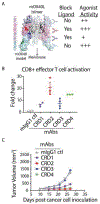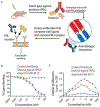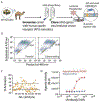Agonist antibody discovery: Experimental, computational, and rational engineering approaches
- PMID: 34571277
- PMCID: PMC8714685
- DOI: 10.1016/j.drudis.2021.09.008
Agonist antibody discovery: Experimental, computational, and rational engineering approaches
Abstract
Agonist antibodies that activate cellular signaling have emerged as promising therapeutics for treating myriad pathologies. Unfortunately, the discovery of rare antibodies with the desired agonist functions is a major bottleneck during drug development. Nevertheless, there has been important recent progress in discovering and optimizing agonist antibodies against a variety of therapeutic targets that are activated by diverse signaling mechanisms. Herein, we review emerging high-throughput experimental and computational methods for agonist antibody discovery as well as rational molecular engineering methods for optimizing their agonist activity.
Keywords: Activation; Agonist; Antibody; Biologic; Discovery; Engineering; Function-based screening; High throughput; mAb; signaling.
Copyright © 2021 Elsevier Ltd. All rights reserved.
Conflict of interest statement
Declaration of interests
The authors declare no conflicts of interest.
Figures







References
-
- De Felice FG, Ferreira ST, Inflammation, defective insulin signaling, and mitochondrial dysfunction as common molecular denominators connecting type 2 diabetes to Alzheimer disease, Diabetes. 63 (7) (2014) 2262–2272. - PubMed
-
- Begue B, Verdier J, Rieux-Laucat F, Goulet O, Morali A, Canioni D, et al., Defective IL10 signaling defining a subgroup of patients with inflammatory bowel disease, Am J Gastroenterol 106 (8) (2011) 1544–1555. - PubMed
-
- Van den Berghe G, Wouters P, Weekers F, Verwaest C, Bruyninckx F, Schetz M, Vlasselaers D, Ferdinande P, Lauwers P, Bouillon R, Intensive insulin therapy in critically ill patients, N Engl J Med. 345 (19) (2001) 1359–1367. - PubMed
Publication types
MeSH terms
Substances
Grants and funding
LinkOut - more resources
Full Text Sources

